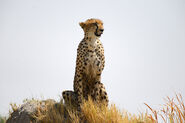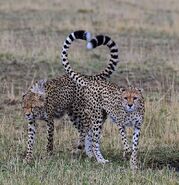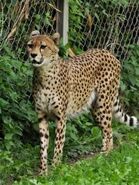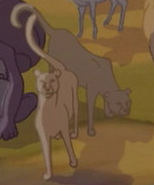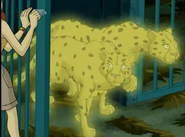The Southeast African cheetah (Acinonyx jubatus jubatus) is the nominate cheetah subspecies native to East and Southern Africa. The Southern African cheetah lives mainly in the lowland areas and deserts of the Kalahari, the savannahs of Okavango Delta, and the grasslands of the Transvaal region in South Africa. In Namibia, cheetahs are mostly found in farmlands.
Taxonomy[]
The Southern African cheetah was first described by German naturalist Johann Christian Daniel von Schreber in his book Die Säugethiere in Abbildungen nach der Natur mit Beschreibungen(The Mammals illustrated as in Nature with Descriptions), published in 1775. Schreber described the species on basis of a specimen from the Cape of Good Hope. It is therefore the nominate subspecies. Subpopulations have been called "South African cheetah" and "Namibian cheetah."
Physical Characteristics[]
The cheetah is a medium-sized cat. An adult male cheetah's total size can measure from 168 to 200 cm (66 to 79 in) and 162 to 213 cm (64 to 84 in) for females. Adult cheetahs are 70 to 90 cm (28 to 35 in) tall at the shoulder. Males are slightly taller than females and have slightly bigger heads with wider incisors and longer mandibles.
Measurements taken of wild cheetahs in Namibia indicate that the females range in head-and-body length from 113 to 140 cm (44 to 55 in) with 59.5-to-73.0 cm (23.4-to-28.7 in) long tails, and weigh between 21.0 and 63.0 kg (46.3 and 138.9 lb); males range in head-and-body length from 113 to 136 cm (44 to 54 in) with 60-to-84 cm (24-to-33 in) long tails, and weigh between 28.5 and 65.0 kg (62.8 and 143.3 lb).
The cheetah has a bright yellow or sometimes a golden coat, and its fur is slightly thicker than that of other subspecies. The white underside is very distinct, especially on the neck and breast, and it has less spotting on its belly. The spots on the face are more pronounced, and as a whole its spots seem more dense than those of most other subspecies. The tear marks are notably thicker at the corners of the mouth, and almost all of them have distinct brown mustache markings. Like the Asiatic cheetah, it is known to have fur behind its tail and have both white and black tips at the end of its tail. However, the cheetah may also have only a black tip at the end of its tail.
In desert areas, such as the Kalahari, cheetahs are somewhat smaller and lighter in weight, with thinner, bright-colored fur, a trait the Northwest African cheetah also has.
King Cheetah[]

A King Cheetah with its distinguishing backside stripe pattern.
The king cheetah is a variety of cheetah with a rare mutation for cream-colored fur marked with large, blotchy spots and three dark, wide stripes extending from their neck to the tail. In 1926, Major A. Cooper wrote about an animal he had shot near Salisbury (modern-day Harare) in southern Rhodesia (modern-day Zimbabwe). Describing the animal, he noted its remarkable similarity to the cheetah, but the body of this individual was covered with fur as thick as that of a snow leopard and the spots merged to form stripes. He suggested that it could be a cross between a leopard and a cheetah. After further similar animals were discovered, it was established they were similar to the cheetah in having non-retractable claws - a characteristic feature of the cheetah.
English zoologist R. I. Pocock described it as a new species named Acinonyx rex, which translated to "king cheetah". However, he reversed this decision in 1939 due to lack of evidence; but in 1928, a skin purchased by the English zoologist Walter Rothschild was found to be intermediate in pattern between the king cheetah and spotted cheetah and English hunter-naturalist Abel Chapman considered it to be a color form of the spotted cheetah. 22 such skins were found between 1926 and 1974. Since 1927, the king cheetah was reported five more times in the wild. Although strangely marked skins had come from Africa, a live king cheetah was not photographed until 1974 in South Africa's Kruger National Park. Cryptozoologists Paul and Lena Bottriell photographed one during an expedition in 1975. They also obtained stuffed specimens. It appeared larger than a spotted cheetah and its fur had a different texture. There was another wild sighting in 1986 — the first in seven years. By 1987, 38 specimens had been recorded, many from pelts.
In May 1981, two spotted sisters gave birth at the De Wildt Cheetah and Wildlife Centre (South Africa) and each litter contained one king cheetah. The sisters had both mated with a wild male from the Transvaal region (where king cheetahs had been recorded). Further king cheetahs were later born at the Centre. It has been known to exist in Zimbabwe, Botswana and in the northern part of South Africa's Transvaal province. In 2012, the cause of this alternative coat pattern was found to be a mutation in the gene for transmembrane aminopeptidase Q (Taqpep), the same gene responsible for the striped "mackerel" versus blotchy "classic" patterning seen in tabby cats. Hence genetically the king cheetah is simply a variety of the common cheetah and not a separate species. This case is similar to that of the black panthers. The mutation is recessive, which is a reason behind the rareness of the mutation. As a result, if two mating cheetah have the same gene, then a quarter of their offspring can be expected to be king cheetah.
Feeding Habits[]
Cheetahs generally hunt relatively small animals, like impala. They depend upon their sight to pinpoint, stalk and chase prey. Coalitions of males, however, are able to take down bulkier animals, such as wildebeest. They will select the least vigilant animal on the edge of the group as their victim. Although cheetahs are the fastest land mammals, they cannot maintain their top speed of around 60 miles per hour for more than 200 to 300 yards. So, unless they are able to come undetected within 100 feet of their prey before starting a chase, cheetahs are rarely successful.During a typical kill, a cheetah uses its forefeet to knock the running animal off balance, then clamps tightly on to its neck to strangle it. The dead prey is invariably dragged into cover where the cheetah will feed. Females will call their cubs to the kill with a soft, bird-like chirrup.
Behavior[]
Cheetahs are most commonly found in savanna parks, in addition to other areas where they are able to hunt their preferred prey—species such as impala. The cheetah is the most endangered of Africa’s large cats, including leopards and lions. This may be because, unlike leopards, they are not as easily able to adapt to changes in their environment being impacted by human encroachment.
Cheetahs are normally stealthy, solitary animals, with the exception of breeding pairs and females with cubs. Additionally, young cheetahs who have just left their mothers will temporarily join together, and males will form coalitions to hunt and guard territories. Males and females only socialize while the female is in heat. They select breeding areas that have a reasonable number of gazelles, good hiding places for cubs, perennial water and relatively low densities of possible cub predators. Males tend to congregate in these areas, which makes that terrain more accessible for them to mate with local females.





